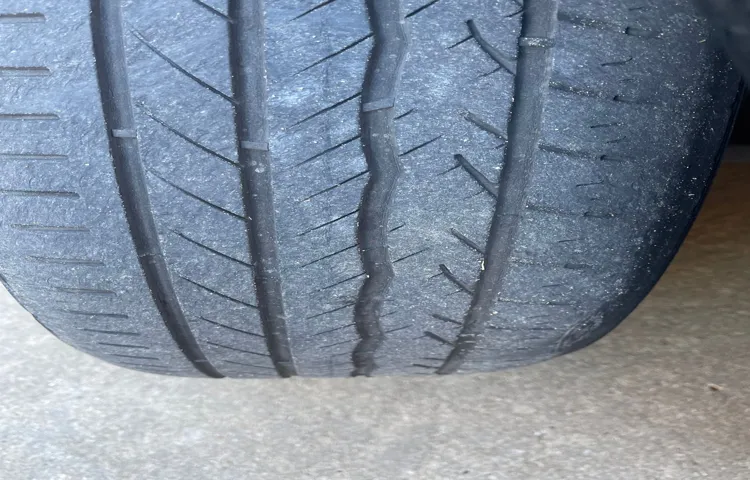Have you ever taken a glance at your car and realized that your tire looks slanted? It can be a perplexing sight, leaving you stuck with lots of questions like “Why is my tire looking asymmetric?” or “Is it normal for my tire to look tilted?” Well, before you panic and think your car might be experiencing some serious mechanical issues or an alignment problem, there are a few reasons why your tire may appear slanted. One of the most common reasons why your tire looks slanted could be due to low tire pressure. When your tire pressure is low, one side of the tire collapses, causing it to appear slanted.
Additionally, a worn-out suspension system or damaged strut can also cause your tire to lean inwards or outwards, creating a similar appearance. Moreover, if you’ve recently hit something on the road or curb, it’s possible that your tire’s alignment has been knocked off, making it appear slanted. While a slanted tire may not seem like a significant concern on the surface, it can still affect your car’s overall performance and lifespan.
A misaligned tire can cause uneven wear, tire failure, and even a decrease in gas mileage. If you’re noticing a slanted tire, it’s highly recommended that you take your car to a professional mechanic to diagnose the issue and fix it as soon as possible. In doing so, you can prevent any other potential problems from arising and keep you and your vehicle safe while on the road.
Possible Reasons for a Slanted Tire
Are you wondering why your tire looks slanted? There could be several potential reasons for this issue. One possibility is that your tire may be underinflated. When a tire doesn’t have enough air, it can cause the sidewalls to sag, making the tire look slanted.
Another possible cause could be a suspension problem or alignment issue. These problems can cause the tire to tilt inward or outward, resulting in a slanted appearance. Additionally, a worn-out tire with uneven tread wear can also cause a slanted appearance.
It’s essential to address this issue promptly, as it could compromise your vehicle’s safety and longevity. Make sure to have your tire inspected by a professional to determine the source of the problem and get it fixed as soon as possible. Remember to check your tire’s pressure regularly and have your vehicle’s alignment checked periodically to avoid potential issues.
1. Misaligned Wheels
If your car’s tire looks slanted, the most likely culprit is misaligned wheels. There are several reasons why wheels can become misaligned, including hitting a curb or pothole, worn suspension components, or an accident. When wheels are misaligned, they are not pointing in the right direction and can cause uneven wear on the tire, affecting its performance.
Driving with misaligned wheels can also lead to other issues with your vehicle, such as a vibrating steering wheel or poor handling. To ensure your car is safe to drive and your tires last as long as possible, it’s essential to have your wheels aligned regularly by a professional mechanic.
2. Uneven Tire Wear
Uneven tire wear is a common issue that many drivers face. If you notice that one or more of your tires are wearing down more quickly on one side, then it’s likely that your car has a slanted tire. There are several reasons why a tire may become slanted.
One of the most common reasons is underinflation. When a tire is not inflated to the proper pressure, one side of the tire may wear down faster. Other possible reasons include worn out suspension components, misaligned wheels, and improper tire mounting.
Regardless of the cause, it’s important to take action as soon as possible to prevent further damage to your tires and ensure your safety on the road. If you suspect that your tires are becoming slanted, it’s best to have them inspected by a professional mechanic who can diagnose and fix the underlying issue. By addressing the problem promptly, you can avoid more costly repairs in the future and extend the life of your tires.
3. Low or Uneven Tire Pressure
Low or uneven tire pressure is a common cause of slanted tires. When a tire is not inflated at the recommended pressure, it can cause the tire to wear unevenly. This can lead to a slant in the tire, making it appear as if it’s leaning to one side.
Low tire pressure can also make your vehicle less stable, causing it to pull to one side while driving. It’s important to regularly check your tire pressure, especially before long road trips, to ensure that your tires are inflated to the recommended pressure. If you notice that your tires are low on pressure, be sure to fill them up right away.
Additionally, make sure your tires are balanced and rotated regularly to avoid uneven wear which can contribute to a slanted tire. Keeping your tires in top condition can not only improve your vehicle’s performance but also extend their overall lifespan.
4. Bent Wheel Rim
If you notice that your car’s tire is slanted or unevenly worn out, it could be due to a bent wheel rim. This can occur if you hit a curb or pothole when driving, causing the rim to become distorted. Driving with a bent rim can be dangerous as it may cause your tire to lose air or blow out while driving, putting yourself and others at risk.
In addition, a bent wheel rim can cause uneven tire wear, leading to the need for frequent tire replacements. If you suspect that your tire is slanted due to a bent wheel rim, it’s best to take your car to a mechanic to diagnose and repair the issue. Replacing a bent rim can be costly, but it’s necessary for the safety and longevity of your car.
Remember to drive carefully and avoid hitting obstacles on the road to prevent bent wheel rims and other potential car issues.
How to Fix a Slanted Tire
Have you ever looked at your car tires and noticed that one looks a bit slanted? This can happen for a few reasons, including a worn-out suspension, an alignment issue, or your tire might simply be low on air. A slanted tire can lead to a bumpy ride and uneven tire wear, so it’s important to address the problem as soon as possible. First, check your tire pressure and make sure it matches the recommended pressure from the manufacturer.
If that doesn’t fix the issue, take your car to a mechanic and have them check your suspension and alignment. Ignoring a slanted tire can lead to more serious problems down the line, so it’s best to tackle it early on.
1. Get a Wheel Alignment
If you’ve noticed that your tire is tilting or slanting, it’s most likely time for a wheel alignment. A wheel alignment is an adjustment made to your vehicle’s suspension system, which affects the way your tires make contact with the road. Over time, small bumps and everyday wear and tear can cause your wheels to become misaligned and cause uneven wear on your tires.
A slanted tire may not only make your ride bumpy and uncomfortable but also pose a safety hazard. Getting a wheel alignment is a relatively quick and easy process that involves adjusting the angles of the wheels to ensure they are perpendicular to the ground and parallel to each other. It’s best to get a wheel alignment check every six months or if you notice any symptoms like a slanting tire, uneven tire wear, or vibrations and pull to one side.
By ensuring your wheels are properly aligned, you can increase your tire’s lifespan, improve fuel efficiency, and enhance your driving experience.
2. Replace Worn Tires
It’s important to keep your tires in good condition, as they’re a crucial part of your vehicle and your safety on the road. If you notice that one of your tires is slanted, it’s a sign that something isn’t right. This could be due to a variety of factors, such as worn treads, a puncture, or an alignment issue.
Whatever the cause, it’s essential to get it fixed as soon as possible. Driving with a slanted tire can cause uneven wear, reduced traction, and even a blowout. To fix a slanted tire, you may need to replace it with a new one.
Make sure to choose a tire that’s the same size and type as your other tires for optimal performance. Additionally, if you’re not sure why your tire is slanted, it’s a good idea to have a professional mechanic inspect your vehicle to identify the root cause of the problem. Remember, taking care of your tires means taking care of your safety on the road, so don’t neglect any signs of wear or damage.
3. Check and Adjust Tire Pressure
If you’ve ever noticed that your car is pulling to one side or another, it could be a sign that your tire is slanted. This is a common issue that can occur due to various reasons, such as improper alignment or suspension problems. Thankfully, fixing a slanted tire is relatively easy.
First, you’ll need to check and adjust your tire pressure. Low tire pressure can cause your car to pull to one side, while overinflated tires can make your vehicle ride rough. Use a tire pressure gauge to check the air pressure in each tire and adjust as needed.
Once your tire pressure is optimal, take your vehicle for a test drive to see if the issue is resolved. If not, you may need to take your car to a mechanic to diagnose and fix any underlying issues. Remember, taking care of your tires not only ensures a smooth and safe ride, but it can also extend the life of your tires, saving you money in the long run.
4. Repair or Replace Bent Wheels
If you’ve noticed that your car’s tire is slanted, it may be due to a bent wheel. Driving on a misaligned tire can cause uneven tire wear and reduces the life of your tires. To fix the problem, first, ensure that you have a bent wheel by looking at the tire closely.
If there is visible damage to the wheel, it is likely bent. Next, take your vehicle to a professional mechanic for an inspection and repair. Depending on the severity of the damage, they may be able to repair the wheel or replace it altogether.
It’s important to have the issue fixed as soon as possible to prevent further damage to your vehicle and ensure your safety on the road. Remember, regular maintenance of your car tires and wheels can help prevent issues like bent wheels from occurring in the first place and save you time and money in the long run.
Conclusion
Well, dear tire owner, the reason your tire may appear slanted could be due to a variety of factors. Perhaps you’ve hit a curb or pothole, causing misalignment. Or, it could be a simple case of uneven wear and tear.
Maybe your tire just needed a vacation and decided to lean a little to the left for a change. Regardless, it’s important to have your tire checked by a professional to ensure it’s not only visually pleasing but also safe for the road. Remember, a perfectly aligned tire is a happy tire.
Happy driving!”
FAQs
What are the causes of a slanted tire?
A slanted tire can be caused by various factors, such as worn-out suspension components, misalignment, improper inflation, and damaged tires.
How can I tell if my tire is slanted?
You can tell if your tire is slanted by visually inspecting it or by noticing irregular wear patterns. If one side of the tire appears to be more worn than the other or the vehicle pulls to one side, it may be a sign of a slanted tire.
Is driving with a slanted tire safe?
No, it is not safe to drive with a slanted tire as it can affect the vehicle’s handling and steering. It also puts extra stress on the tire, which can lead to premature wear and potential blowouts.
How can I fix a slanted tire?
The best way to fix a slanted tire is to have it inspected by a professional mechanic or tire technician. They can determine the cause of the slanted tire and make the necessary repairs, such as realigning the wheels and replacing damaged components.
How often should I check my tires for slanting?
You should check your tires for slanting regularly, at least once a month or before long road trips. It is also recommended to check your tires after hitting potholes or other road hazards that can cause damage.
Can a slanted tire affect my fuel efficiency?
Yes, a slanted tire can affect your fuel efficiency as it causes additional friction between the tire and the road. This can lead to increased resistance, which requires more energy from the engine, resulting in reduced fuel efficiency.
What should I do if I notice my tire is slanted while driving?
If you notice your tire is slanted while driving, it is best to pull over safely and have it inspected by a professional. Driving on a slanted tire can be unsafe and lead to further damage to your vehicle and tires.



